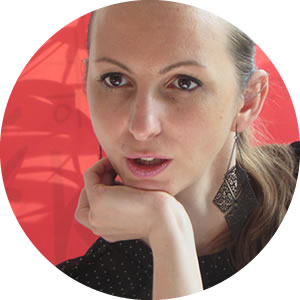Imagine that...
...you live in the year 2040.
Who are you? What do you do? Who are your loved ones? What kind of relationships do you have with different people? How do you communicate? What different technologies do you use? What does your typical day look like? What is important to you? What is important to other people? What do you need to know, be aware of, be skilled at? How do you learn? How do children learn in 2040?
With these and similar questions, we started our workshops with children and adults at various sites in Slovakia. Together, we thought about different forms of education, and we deliberately moved our minds 25 years into the future. We wanted to break away from the problems and shortcomings of the current education system. Not that we consider them unimportant, but we wanted to avoid the habitual tendency to look for those to blame, or to avoid responsibility for the current condition of our education system.
We already know enough about what does not work in education in Slovakia. Analyses, statistics, and various reports on the current condition of education are available. There are also a number of visions and forecasts for the development of our society as a whole, including outlines of how education may be shaped in the future.
What we miss when we think about education is a link between what the data and forecasts indicate and what people really want.
Therefore, we have decided to introduce the perspectives of those who live by education every day – children, parents and teachers – as well anyone else who may influence and shape education. With the campaign, we want to know more about the future of education in Slovakia and we want to give the voice in public discussions back to people.
HARD DATA FAILS TO CAPTURE HUMANNESS
Every society is diverse. No education system can really function if it only fulfills the expectations of a certain cohort of the population while requiring acceptance by all. Such a society is not free, democratic, or modern, as it keeps some citizens on the sidelines.
The purpose of our campaign was to show that it is legitimate to have diverse learning requirements, and that the education system should account for them. It should be open and flexible enough to draw positive inspiration from new impulses while having solid grounds and simple rules to withstand these inner dynamics without difficulties.
A truly good education system is not one that is resistant to outside influences, but one that counts with them and uses them for its continuous improvement.
In many ways, the Slovak education system is the opposite – it is robust in rules and fragile in fundamentals. Past attempts to change it have neither strengthened the fundamentals nor simplified the rules. Numerous top-down measures have not been tested well enough in practice to observe any real improvement in education processes or their results. Indeed, change will not happen unless those who work in education every day identify with it a change also that respects their demands and needs.
Education in Slovakia lacks vision. Minor flaws are constantly corrected while fundamental problems are not addressed. If any suggestions for change are to really work, they cannot only be derived from "hard data", but must also take into account the variety of opinions and value preferences of people. The lack of understanding of this necessity is the reason why even the best intended education reform is doomed to fail.
We need to talk about this right now, so that we have a better grounding about the notoriously known facts and less known forecasts in our lives and in our thinking. Only after having mapped what people really care about in life and what they expect from education is it possible to search for ways to reconcile diverse views and look for solutions beneficial to all.
THE ATLAS IS DESIGNED TO STIMULATE DEEPER THINKING
Education needs to be discussed from a higher perspective with our sights set on the future. Besides listening to the views of experts, it is necessary to hear about experiences of non-experts as well. To break away from the issues of the day, we need a mental shift in time and an expansion of perspective.
We need to know about the development trends of our society and the challenges we face as a result. We need to examine the roots of people’s values, their lifestyles, the changing forms of family and working life, and the blending of private and public activities. We need to anticipate what children and adults will need to know to be successful in life, and under what conditions and in what ways they can best learn it. Our Atlas brings it all – the trends, the challenges, the facts, the research findings, and the expectations of people.
Naturally, the views of people on the same issue differ. Even one person can have frequently diverse or contradictory ideas. In the Atlas, we work with this in two ways.
We respect the authenticity of the statements made by different people while looking for their deeper context and thinking about possible consequences.
The Atlas deliberately creates a tension between what people expect in terms of already recognizable trends, what they may consider as a negative direction in the development of society, and what they articulate as desirable for the future. This takes place against the backdrop of three "model-based" futures, which are there to help us combine various ideas into a coherent context.
The models of the future are not scientific forecasts, but do incorporate their essence, freely retold. They may be useful in uncovering the values and ideas every one of us prefers regarding the functioning of our society. They should also encourage us to make comparisons and combine various available options.
The first model indicates how a society could look like if its core value is freedom. We referred to such a society simplistically as 'individualistic'. For the second type of society, the most important value is solidarity, and we referred to it as 'communitarian'. Finally, the third type of society is 'collectivist’ and its core principle is equality.
Each model has its strengths and also carries risks. None can be put in practice in their entirety, if only because this will not be generally accepted in a pluralistic society.
CHILDREN AT THE CENTER OF ATTENTION
We did not introduce our own values or personal preferences into the three models. In each one, we can identify some aspects we actively encourage, those we can identify with only to some extent, and others that we consider to be problematic or absolutely unacceptable.
The single, yet fundamental, principle that we purposefully introduced in the Atlas and the entire campaign is to look at the education system from the perspective of children, through the lens of their needs and expectations.
Through this perspective, we sorted out the available facts, findings, and possible future scenarios. We did so precisely because the perspective of children is extrinsic to the Slovak education system. We do not have a suitable Slovak translation for the English-language term well-being. The best interest of the child is often replaced in our country by assumptions of adults who "know" what is good for children even without asking them. It is one of the reasons why education, social work, or youth work is often more reflective of the needs of institutions than the children in them.
In schools, this perspective is reflected in the blind application of the one-size-fits-all approach and the fictional concept of an "ordinary student" who manages everything according to the prescribed content, extent, time, pace, and quality. Our education system is not ready for the diversity of children and does not even offer sufficient support to those who must deal with it on a daily basis – the teachers and the parents.
In the Atlas, we formulated the three models of the future with a primary focus on children. The core value of each model views well-being from a different perspective. Freedom enables us to perceive the uniqueness of each child and his or her individual needs. Equality guarantees that every child is taken into consideration, regardless of their background, opportunities, and capabilities, and that all children have equal access to quality education. Solidarity is the value that helps cultivate good relations, promotes cooperation and mutual assistance that society could not exist without.
HOW TO USE THE ATLAS
The Atlas is a tool for collaborative thinking about the future of education. Its purpose can be best fulfilled if it encourages discussion, raises arguments, and enriches the proposals for necessary change. Therefore, it links the known facts with the observed or predicted trends, possible challenges, and mapped expectations of people.
The Atlas does not offer ready-made solutions or recipes; it is rather a set of mind maps that allow us to think from perspectives different to our own.
Atlases are not books for a single reading. They show the topography of the land, with altitude being indicated by spot heights and contour lines, and the grid helps to determine the location. Atlases do not set a specific direction.
In our Atlas, the reference points are the different types of texts readers can choose from for themselves, deciding what to focus on and which direction to take.
Each model of the future can be read in one flow from its beginning to the end. However, it is also possible to focus only on selected parts and read horizontally to compare how different aspects are addressed in the other models of the future.
After reading about the models, one might revert back to the trends and challenges and consider how well different models respond to them. You can also skip to the research findings, and observe whether there is an inclination towards one of the models in how people in Slovakia live, what they think, and how they imagine their future.
In addition, one may reflect on the statements made by various people, both experts and laymen, and to observe whether their ideas match with or are opposed to a particular school of thought. Finally, inspiration can be found in the Good to Know parts, including the examples of practice in Slovakia and abroad.
Every place in the Atlas is therefore a kind of crossroads from which one can head in their own direction and at their own speed. During the process of discovery, one can leave the Atlas, delve into a deeper investigation of the documented sources, and then come back to the Atlas at any time.
WHAT IT IS GOOD FOR
Heated debates about the future of education are underway in many countries. People and policy makers in education have realized it is no longer enough to keep on fixing a system that was created for a different age and a different society.
We need to rethink education and set it up to suit the needs of people and the requirements of societies in the 21st century.
Major changes took place 25 years ago in Slovakia, but they did not bring about significant improvements in education. If we don’t continue to procrastinate in the next 25 years, we might be able to say that we have managed to make education more meaningful and useful by 2040. Therefore, today we need to vigorously debate and seek common ground on what educational system we actually want and how we can create it.
After two years of our campaign, we thank to all the children and adults who engaged in the discussions, workshops, and surveys. Also, thanks to them, we now know more about the future of education and can bring some of it to you in this Atlas.







